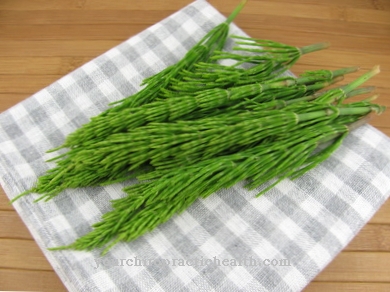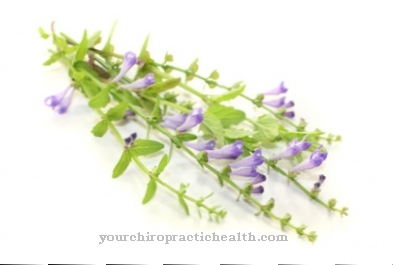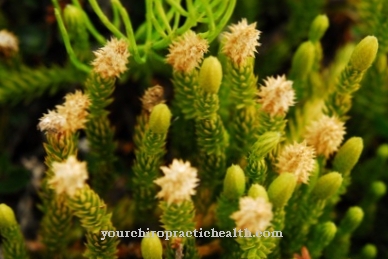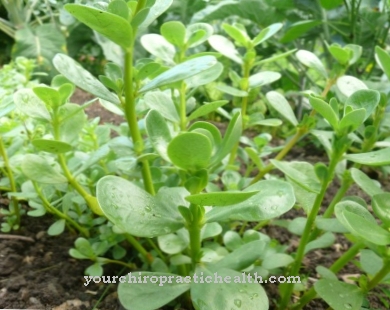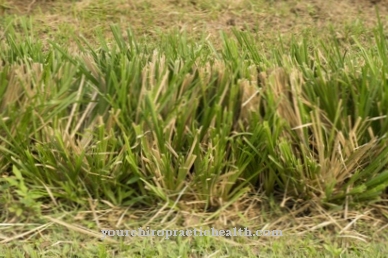Of the Thorn apple is a nightshade plant and a drug plant. In the past, doctors prescribed the herb as a remedy for asthma, restlessness and pain. Today the thorn apple is a garden plant that people with addiction problems abusively consume to get intoxicated.
Occurrence and cultivation of the common stechapel

The thorn apple, which grows about one to two meters high, has serrated, thistle-like leaves. The up to 20 centimeters long, white or pink calyxes are similar to those of the angel's trumpet. The flowering period begins in June and extends into September. The green, round-oval fruits are studded with thorns. As the seeds ripen, they open at the seams of the four carpels. The black seeds are the size of the heads of a pin.
The original form of the thorn apple probably comes from the Mediterranean area, only humans ensured it was spread around the world. In Central Europe, the plants grow in gardens or on overgrown plots. Many cultivated cultivars exist today. The nightshade plant thrives best on soil that is rich in nutrients and not too moist. The ruderal plants develop optimally on debris sites in sunny places (Rudus, Latin: rubble).
Effect & application
All parts of the plant in the thorn apple contain alkaloids. The chemicals in this class of substances are organic nitrogen compounds that have an alkaline reaction (counter-reaction to acidic properties). The most important alkaloids of the nightshade family are scopolamine and hyoscyamine, which have two effects in the body: firstly, they release muscle spasms and secondly, they influence nerve functions.
The latter happens because the alkaloids influence the transmission of stimuli between the nerve cells. They reduce or increase the release of neurotransmitters. These are messenger substances that one nerve cell sends to the next in order to trigger an electrical transmission of the signal. Hyoscyamine and scopolamine disrupt the biochemical transmission of stimuli between nerve cells.
In the entire nervous system, this not only causes pain relief, but also psychological relaxation and intoxication. An overdose of the alkaloids can trigger psychotic states and hallucinations and even lead to death. The lethal dose (lethal amount) is 0.05 grams, whereby the consumer dies from respiratory paralysis.
Even the people of the Stone Age used the thorn apple as a narcotic drug. The hallucinogenic effects were valued by some ethnic groups for ritual and religious purposes and probably also had a meaning in shamanism. It was customary to smoke the dried leaves or to make tea. In the Middle Ages, healers put the plant parts on wounds to relieve pain. Doctors still prescribed thorn apple cigarettes as medicine well into the 19th century.
Today thorn apple preparations are used in homeopathy and are available in pharmacies as alcoholic extracts or tablets. In addition, the thorn apple hardly plays a role in pharmacy today because there are alternative drugs. The modern remedies work better and have fewer side effects.
Datura stramonium falls under the Medicines Act (AMG). This means that dealers are only allowed to offer the seeds and plants if they do not claim that the product is medicinal or can be ingested orally. That is why the nightshade plant is only available on the market as an ornamental plant, where gardening enthusiasts can purchase the seeds or saplings of the thorn apple. Because the plants have a decorative appearance and the dried fruits are well suited for making autumn arrangements.
Importance for health, treatment & prevention
But not only flower lovers buy the thorn apple. People with addiction problems also get the seeds on the legal market and grow the seedlings or harvest fruits and leaves from wild locations. The consumption is supposed to create a high, but carries a high risk. Because the content of alkaloids in the raw drug is subject to strong fluctuations. The literature states that the concentration of scopolamine and hyoscyamine can be between 0.2% and 0.6% (based on the fresh weight).
This depends not only on the genetic makeup of the plant, but also on the ecological site conditions. The strongly varying alkaloid content makes it difficult to estimate a tolerable dose. This can lead to death among consumers.
In the 19th century, doctors used scopolamine and hyoscyamine to treat bronchial asthma and other severe cough diseases. In many pharmacies, thorn apple leaves were available as cigarettes, which achieved the best effect before the invention of technical-synthetic sprays. In addition, teas made from Datura leaves should help against unrest. Poultices with the leaves of the nightshade family had a soothing effect on rheumatism.
Preparations of the thorn apple were always a means of acute intervention, which was indicated when necessary. On the other hand, long-term medication does not make sense, which is why the preparations are not suitable for the prophylaxis of diseases. Families with young children should not plant the thorn apple in the garden. Because the risk of poisoning is too great.
Doctors and naturopaths currently only prescribe homeopathic Datura preparations in the potentiation from D4 (dilution: one in ten thousand) to D6 (dilution: one in one million). None of the life-threatening side effects are to be expected in these low concentrations. The drugs are said to help against nerve pain and restlessness, but also against severe respiratory diseases with severe coughing attacks. In addition, homeopaths also prescribe the thorn apple remedies for treating infections and inflammatory eye irritation.


